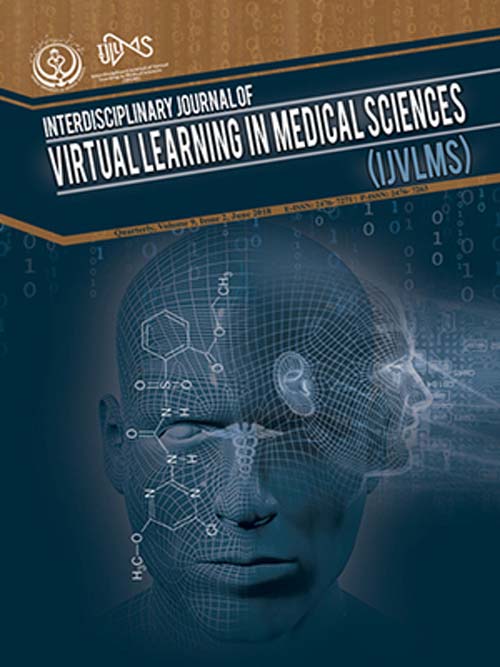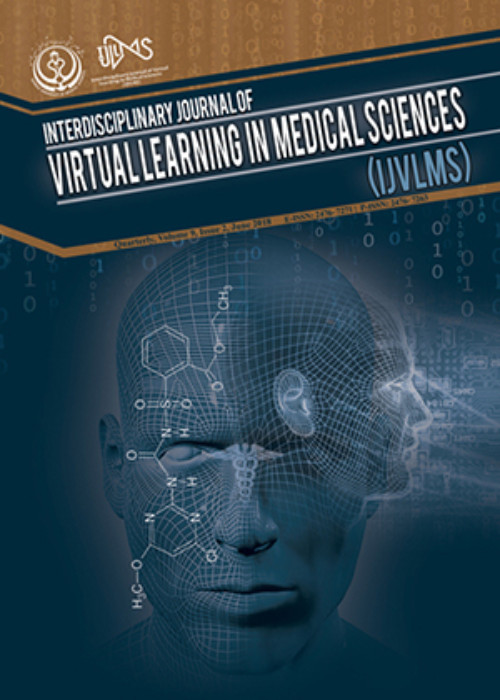فهرست مطالب

Interdisciplinary Journal of Virtual Learning in Medical Sciences
Volume:13 Issue: 1, Mar 2022
- تاریخ انتشار: 1400/12/03
- تعداد عناوین: 8
-
-
Pages 1-14BackgroundNurses play a key role in maintaining and promoting community health; therefore, they need to constantly upgrade and update their professional knowledge through knowledge management process. Nowadays, knowledge-sharing within social networks is considered as a modern and effective strategy for the co-creation of new knowledge that would not be possible without the active participation of the members. The present study aimed to examine experiences of nursing knowledge-sharing in social networks based on smartphones.MethodsThis was a qualitative content analysis conducted between 2017 and 2019 in Tehran, Iran. Participants were eighteen nurses from virtual communities in social network platforms and included nursing-related virtual specialty groups. They were selected by purposive sampling and sampling continued until data saturation was achieved. Strategy of data collection included in-depth and semi-structured interviews. The data were analyzed using Landman and Grenheim method with the aid of MAXQDA 10 software.ResultsDuring the data analysis, six main categories emerged, including: a) “The emergence of virtual communities”, b) “Professional setting”, c) “Professional Virtual Communities”, d) “Dynamic interactions”, e) “Organizing and advancing” and f) “Outcomes of interaction in virtual communities”. Data analysis indicated that the main concern of nurses was professional advancement which encouraged them to create and join virtual communities to share knowledge. Dynamic interactions were also the main phenomenon studied.ConclusionThis study provided a better and deeper understanding of the phenomenon of sharing nursing knowledge in virtual communities based on smartphones. The acquired concepts can be used in creating professional virtual communities as well as diagnosing their complicationsKeywords: interaction, knowledge management, Qualitative research, Smartphone, Social networking, Content analysis
-
Pages 15-22BackgroundDuring the Covid-19 pandemic, teaching and learning have taken a detour, and the unexpected shift from faceto-face to virtual learning has made instructors and learners think about new methods for more effective virtual instruction. The present study aimed at examining a new method for enriching the medical students’ understanding of visual texts through applying Reciprocal Teaching (RT) strategies during the Covid-19 pandemic.MethodsThe study had a qualitative action-research design. The participants of the study were 54 medical students enrolled in an online General English course at Birjand University of Medical Sciences during the Fall semester of 2020. The class was held twice a week for 24 sessions. The strategies of RT were integrated into watching films that were used as teaching materials (visual texts). The researcher used semi-structured interviews and field notes and also recorded the class sessions for data collection. The collected data were analyzed through thematic analysis.ResultsThe results showed that the students found using RT strategies advantageous in the understanding of films and in improving their language proficiency. They reconceptualized the importance of their film-watching habit, and revalued the importance of films for language learning, and considered them as textbooks that could be divided into different sections such as introduction, body, and conclusion. In addition, they discussed different sections of the films with peers and wrote summaries about them which improved both their language proficiency and their knowledge about medical terminologies.ConclusionThe findings of this study showed that applying RT strategies in virtual classes can be advantageous in helping medical students recognize the importance of films and use them as reliable sources for language learning. Therefore, as today’s students are called ‘digital natives’, it is suggested that the RT strategies and the new modes of instruction be integrated into teaching medical students.Keywords: English language learning, Students, Medical, education, Distance, Reciprocal teaching, Teaching, Visual texts
-
Pages 23-33Background
Metacognitive awareness is the most important form of new learning science. It enables the learner to maintain his or her learning path and to think. A seamless flipped learning class reinforces this process. The aim of this study was to investigate the causal relationships between the need to know, metacognitive beliefs, and metacognitive awareness with the mediating role of goal orientation and self-efficacy among students of Shiraz University of Medical Sciences.
MethodsThis was a cross-sectional descriptive-correlational study in terms of methodology. The statistical population of this study included all undergraduate Medical Sciences students at Shiraz University of Medical Sciences who were enrolled in a General English course in the academic year 2020–2021 (n=2455). The study sample included 380 students, who were selected by a multistage sampling method based on Morgan’s table. Participants completed an integrated questionnaire that included: metacognitive awareness, need for cognition, goal orientation, self-efficacy, and metacognitive beliefs. All the questionnaires had good validity and reliability. Path analysis was used to analyze the data, which was done with Amos 22, Lisrel 8.50, and SPSS 22.
ResultsFour factors of metacognitive beliefs, need to know, goal orientation, and self-efficacy have a significant effect on metacognitive awareness in students. Among the endogenous variables, selfefficacy had the most effect (0.19) and metacognitive beliefs had the least effect (0.164) on the metacognitive awareness variable.
ConclusionThe results obtained for the fit indices of the proposed model showed that it had a good fit with the data collected from the respondents. Accordingly, this model can assist educational leaders in their decision-making and policy-making to improve student learning outcomes.
Keywords: Metacognition, Metacognitive beliefs, Need to know, Orientation, Self-efficacy, Seamless flipped learning (SFL) -
Pages 34-42BackgroundCreativity is the process of evolution, development, and reconstruction of existing knowledge, which is regarded as problem-solving. The present study aimed to investigate the effectiveness of flipped classroom and cooperative teaching methods on the creativity of senior high school students.MethodsThe research method was quasi-experimental, with a pre-test and post-test design and a control group. The statistical population included all high school students in Ahvaz in the academic year 2019-2020. Using the cluster-random sampling method, one school was randomly selected from the all-girls senior high schools in Ahvaz. Forty-five students were selected and randomly divided into two experimental groups and a control group (n=15 per group). The research instrument included the Abedi’s Creativity Test (CT). The experimental groups were taught using flipped classroom and cooperative teaching methods, while the control group received usual training. Data analysis was done using a one-way analysis of covariance.ResultsThe mean±SD of the creativity for the flipped classroom, cooperative teaching, and control groups in the post-test phase were 126.60±15.39, 135.90±17.52, and 98.45±13.66, respectively. The results showed that both the flipped classroom and cooperative teaching methods enhanced the creativity of senior high school students (p <0.001).ConclusionsAccording to the results, there was no significant difference between the two methods in terms of creativity in the students. Therefore, the flipped classroom and cooperative teaching methods can be employed to promote students’ motivation and creativity.Keywords: education, Cooperative behavior, Creativity, Flipped Classroom, effectiveness, Students
-
Pages 43-53Background
Studying ethics teaches students to think critically about life, carefully evaluate the activities, choices, and decisions that are encountered at different stages of life, and also take a deeper look at the world. Other dimensions of education have been less investigated than moral aspects of education. The current study aims to investigate the experience of medical ethics in practice among medical students.
MethodsThis is a qualitative study that investigates zone 5 of medical education in Iran. This is a conventional content analysis carried out in 2017. The participants consisted of 44 medical students from five central colleges located in the southern regions of Iran who were selected by the purposeful sampling method. The process of data collection was performed using Focus Group Discussions, and then an inductive data analysis was carried out.
ResultsFive themes and 11 subthemes emerged from the data. The themes included one-dimensional teaching methods, uselessness, negative hidden curriculum, suppression, and ignoring virtual education.
ConclusionIt was shown that the ethics of education in this context was in crisis because the main purposes of medical education were ignored and led to unexpected outcomes that did not follow the main purposes. Medical students were made the focal point of medical education, but they were overlooked in this context. Theoretically, medical instructors had to update their instructional methods to achieve joint interests and mutual understanding with their students. However, it was found that the health system in Iran required a practical curriculum reformation based on the requirements of medical students and the nature of the social environment. It was concluded that medical instructors should change their instructional points of view and behaviors.
Keywords: Medical education, Medical Students, ethics, Virtual Education -
Pages 54-62Background
One of the most common treatments for cardiovascular diseases is coronary angioplasty. Due to the short period of hospitalization, less attention has been given to patients’ education. This study was carried out to investigate the effects of Interactive Multimedia (IM) training on anxiety, uncertainty, and hope among angioplasty patients.
MethodsIn this interventional study, 90 eligible patients were enrolled one day before angioplasty in September-December 2019. Using the block random sampling method, the patients were assigned to IM training (n=45) or an educational pamphlet (n=45). Anxiety, uncertainty, and hope were evaluated at three periods (before, one day, and two weeks after PCI) using the Depression Anxiety and Stress Scales (DASS-21), Mishel Uncertainty of Illness Scale (MUIS), and Snider Hope scale. The Chi-square test, independent t-test, and repeated measurements using SPSS18 were used for statistical analysis.
ResultsOne week and two weeks after the intervention, the hope score was significantly improved; uncertainty and anxiety levels were reduced considerably more in the multimedia group than in the educational pamphlet (p <0.001); and repeated measurement analysis confirmed the effectiveness of IM (p <0.001).
ConclusionIM training reduced anxiety and uncertainty and improved hope among patients. Since most patients were illiterate, IM training was easier and more accessible.
Keywords: Percutaneous Coronary Intervention, Angioplasty, Interactive multimedia training, Uncertainty, Anxiety, hope -
Pages 63-65
Road collisions are the most important cause of wildlife mortality, and almost all countries are involved in some way. Researchers believe that changing the behavior of drivers through e-learning can help reduce road collisions by informing and raising awareness about the negative consequences of animal deaths on the road; installing warning signs, markings and speed bumps, increasing road lighting, and reducing traffic speeds physically or mentally, by creating speed bumps or increasing obstacles and road curves in high-risk areas can also help. Placing wildlife trails or approaching wildlife crossings in navigation programs like Balad and Neshan that are more popular with drivers can help guide traffic and reduce wildlife crashes. People should be taught how to use the software above to find areas where animals are likely to be on the roads. This will help people avoid accidents with animals on the roads and save them both money and time.
Keywords: Software, Wildlife, Driver training, Road collisions


